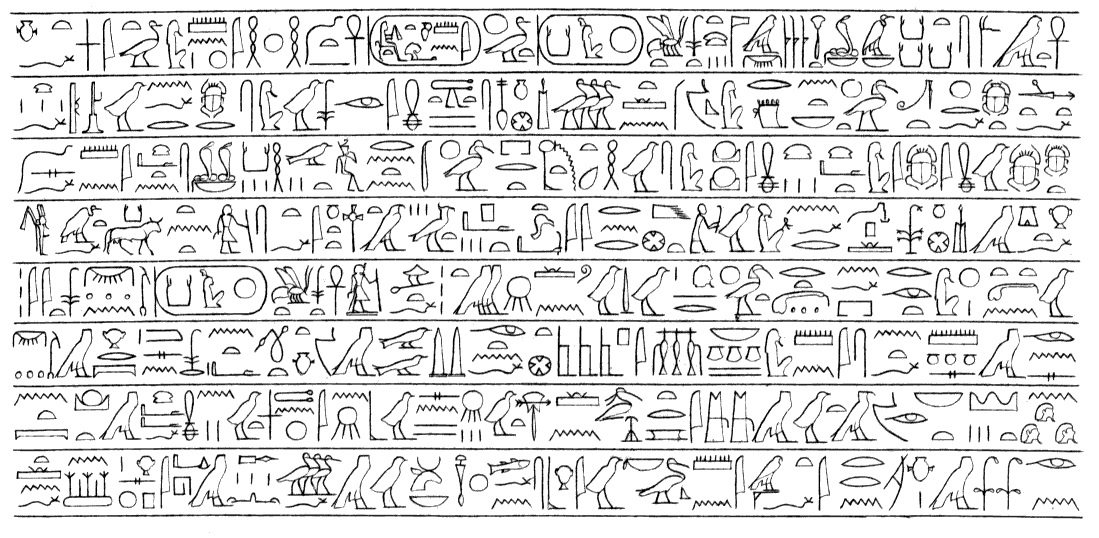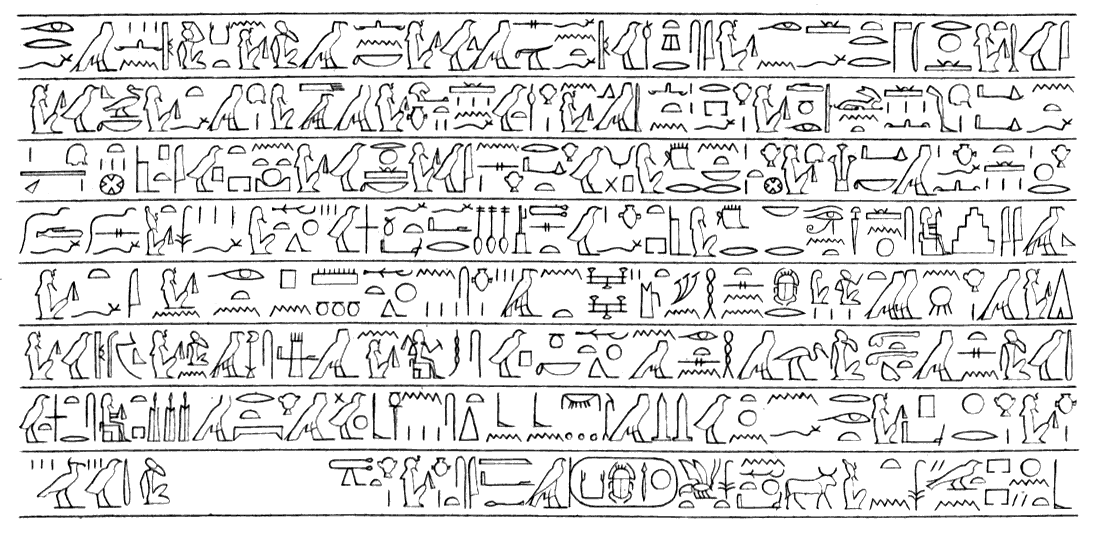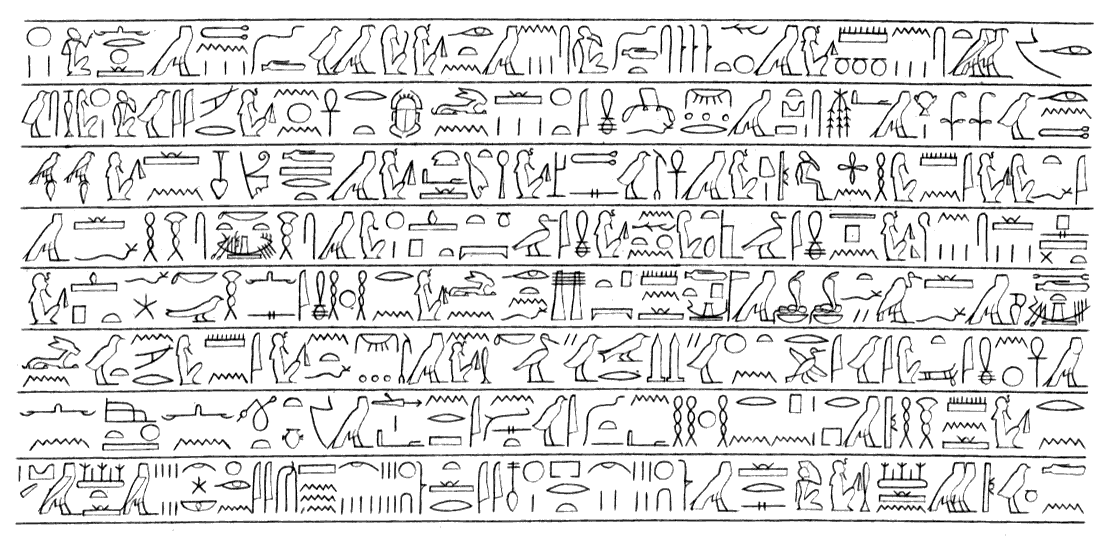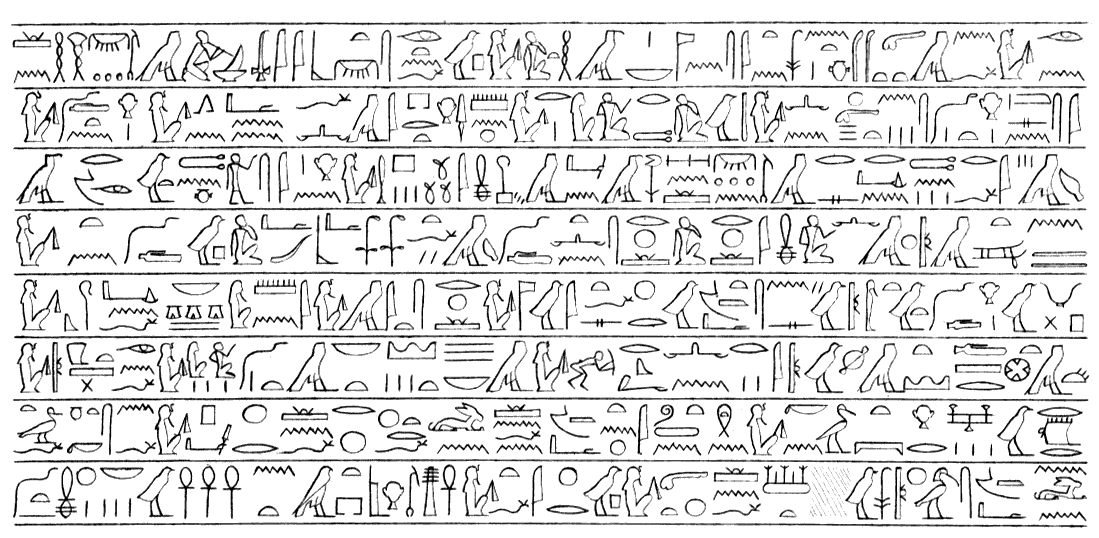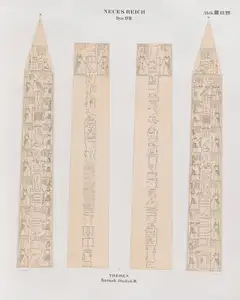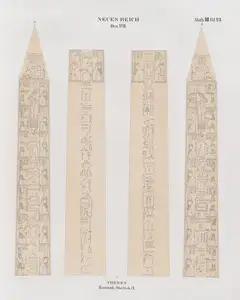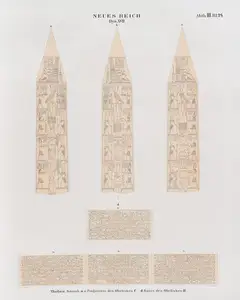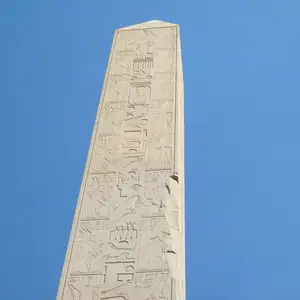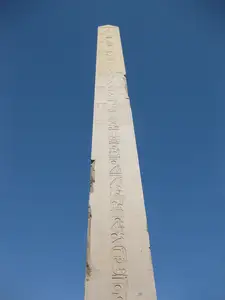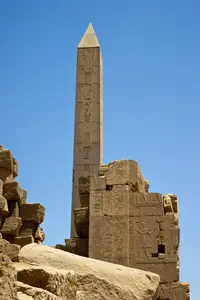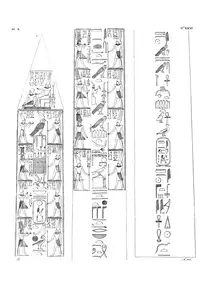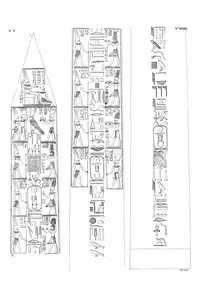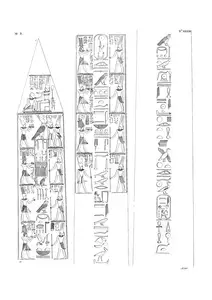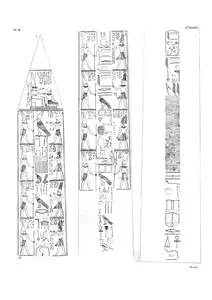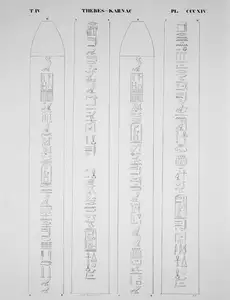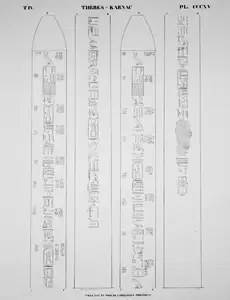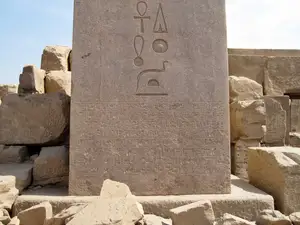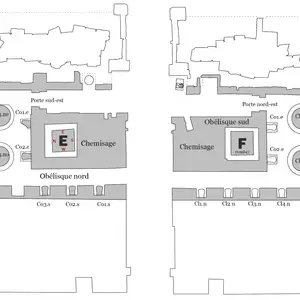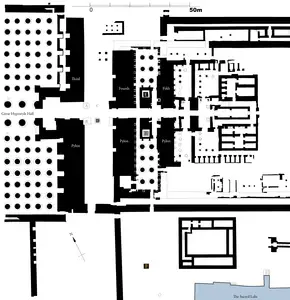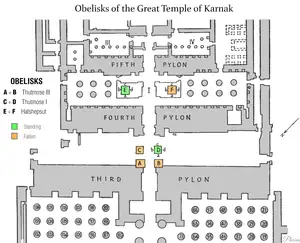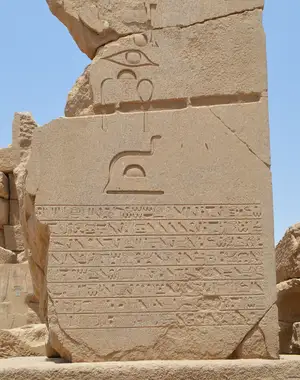The tallest obelisk in Egypt (29.56 m, 97 ft) is in Temple of Amun at the Great Temple complex at Karnak and belonged to Hatshepsut who was a female pharaoh of Egypt in 1473–1458 BCE. It is also known as Obelisk E and was the northernmost of a pair. The southern, Obelisk F, toppled already in antiquity, possibly due to an earthquake, leaving only the base, and the upper part lying by the sacred lake. Despite the fact that her successors systematically erased her name from her most visible monuments, it is ironic that her obelisk still stands where it was erected some 3,500 years ago. Toppling Hatshepsut's two large obelisks, which had been erected between the fourth and fifth pylon of the Great Temple, probably proved impossible without damaging the surrounding structures. Instead, they were likely hidden behind false walls — a simple solution that rendered the obelisks practically invisible.
In 2022 the top part of the toppled Obelisk F (11 m, 36 ft tall) was erected by the Sacred Lake at the side of the Great temple, where it had been lying on its side for decades. The new position is not the original spot for the obelisk, but it is at least in line with its twin. Parts of the central columns were erased and usurped first by Thutmose III and later by Seti I. It is possible that the obelisk was deliberately toppled to erase the memory of Hatshepsut, but its fall caused such destruction that the other obelisk was left standing to avoid further damage to the temple. The base remains inside the temple at the original position. The remaining parts of the base text is not an exact copy of the standing obelisk, and three of the faces of the toppled obelisk have been usurped/altered. The fate of the other pair of her obelisks is unknown; they were probably toppled and dismantled by her successors.
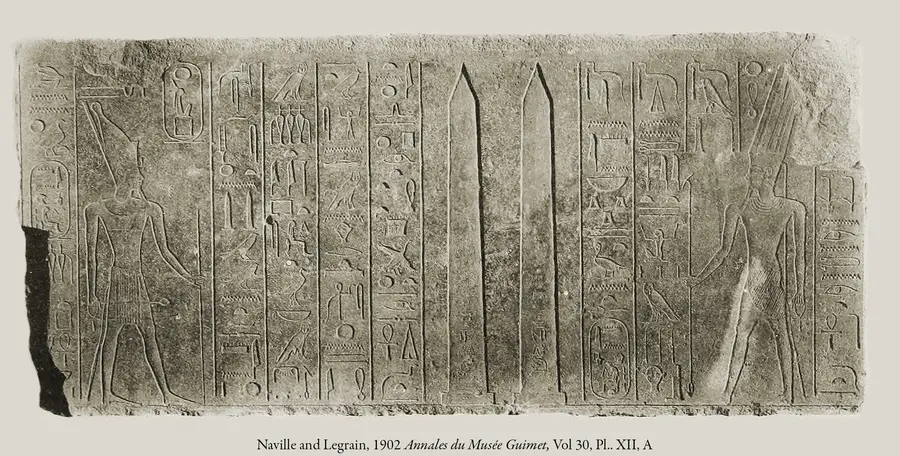
The inscription reads: The king himself; erection of two great obelisks for hersic father, Amon-Ra, in front of the august colonnade, wrought with exceedingly abundant electrum. Their height pierces the sky and illuminates the Two Lands like the sun-disk. Never since the beginning has such a thing been done, that she might be given life.
Inscriptions
Not only does this obelisk contain the usual columned hieroglyphs, but also unique scenes of pharaoh making offerings to a the god Amun. All four pyramidion faces show the Queen kneeling in front of Amun. The upper half of the obelisk contains 8 scenes on each side of the central column text. for a total of 32 scenes. These scenes are later additions showing Hatshepsut, her father Thutmose I, or stepson Thutmose III making offerings to Amun. The only exception is on the fifth west and south scenes, Seti I replaced the name of the queen and added the inscription “Son of Ra, Seti Merneptah, who restored the monument of his father Amun-Ra, Lord of Heaven”.
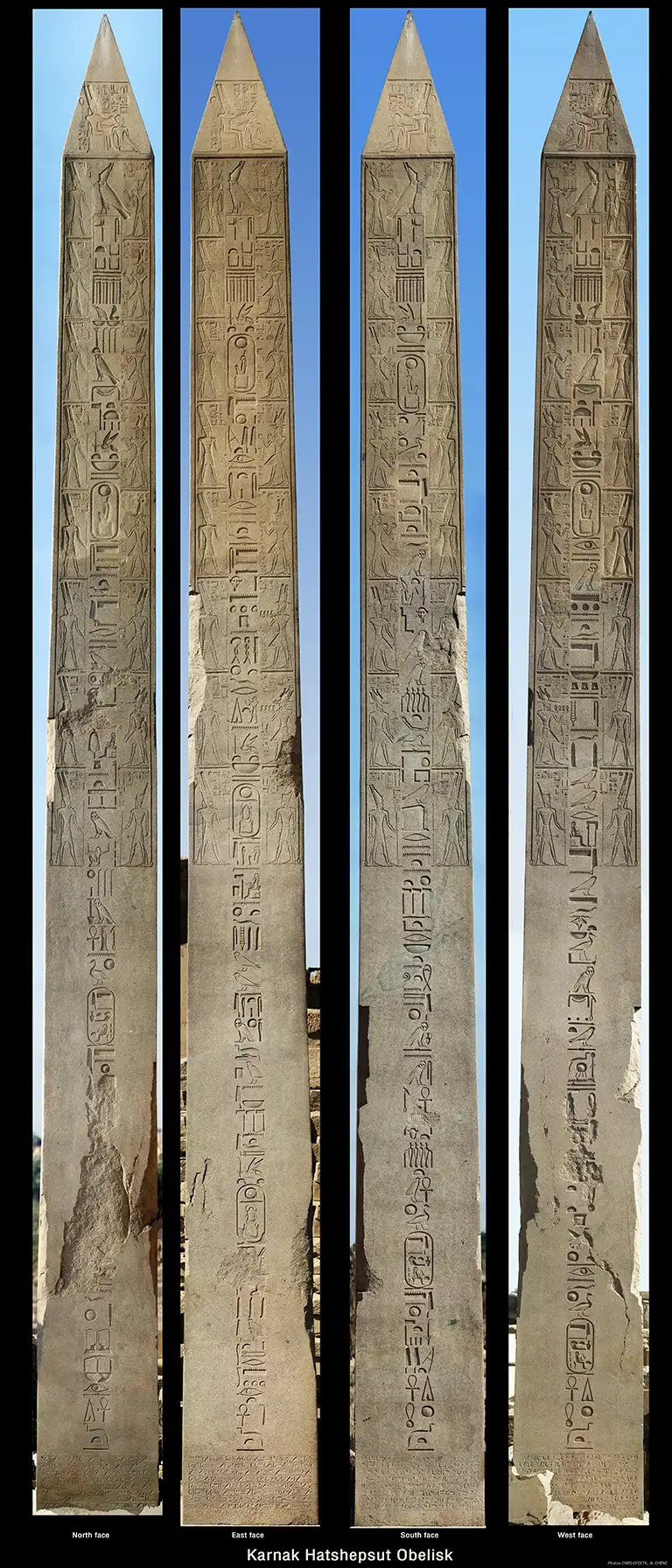
North face
East face
South face
West face
Translation of the inscriptions
North face
Her father Amun has established her great name upon the august Ashed-tree. Her annals are millions of years, united with life, stability, and dominion. The Son of Ra, Hatshepsut, united with Amun, beloved of Amun-Ra, King of the Gods, constructed this beautiful monument which she made for him on the first occurrence of the jubilee, so that she will have life forever.
East face
Her Majesty has recorded the name of her father on this enduring monument. Inasmuch favor was shown to the Dual King, Lord of the Two Lands: Aakheperkara by the majesty of this god, accordingly these two great obelisks were erected by her majesty for the first time. For it was said by the Lord of the Gods: "Your father, the Dual King, Aakheperkara, gave instruction to erect obelisks, and your majesty shall multiply monuments, so as to live forever."
West face
She made as her monument for her father Amun, Lord of Thrones of the Two Lands, the erecting for him of two great obelisks at the august portal, "Amun-great-in-majesty." Wrought with very fine gold, they illuminate the Two Lands like Aten. Never was the like made since earth's beginning. Made for him by the
South face
Transliteration
It is not possible to translate hieroglyphs directly; first, the hieroglyphs must be converted into alphabetic writing, a process known as
transliteration, which employs numerous letters not typically found on keyboards:
North face
ḥr wsrt kꜢw nbty wꜢḏt rnpw dḥr nbw nṯrt ḫaw n-sw-bit nb tꜢwy mꜢat-kꜢ-ra s mn n it.s imn rn.s wr mꜢat-kꜢ-ra dḥr idšd gnwt.s m dḥdḥw nw rnpw smꜢ m anḫ ḏd wꜢs sꜢ ra imn-ẖmnt imn-ra nsw nṯr mrit m isw mnw pn nfr rwḏ ir.n.s n f sp tpy dḥb-sd ir.s di anḫ ḏt
East face
ḥr wsrt kꜢw n-sw-bit mꜢꜤt-kꜢ-rꜤ imn-rꜤ mrit ir.n dḥmt.s rn n it.s s mn dḥr mnw pn wꜢdḥ ḫft rdit n n-sw-bit nb tꜢwy ꜤꜢ-ḫpr-kꜢ-rꜤ in dḥm n pn nṯr ḫft sꜤdḥꜤ tḫmy wry in dḥmt.s m sp tpy ḏd pw in nb nṯrw in it ṯ n-sw-bit ꜤꜢ-ḫpr-kꜢ-rꜤ di tp rd s mnt tḫnw iw dḥmt ṯ r wdḥm mnw ir.t Ꜥnḫ ti ḏt
West face
ḥr wsrt kꜢw nbty wꜢḏt rnpw dḥr-n-nbw nṯrt ḫꜤw n-sw-bit nb tꜢwy mꜢꜤt-kꜢ-rꜤ ir.n.s m mnw.s n it.s imn nb nswt tꜢwy sꜤdḥꜤ n f tḫnwy wry r sbꜢ dšps imn wr dšfyt bꜢk m ḏꜤmw ꜤꜢ wrt dḥd n t3wy mi iṯn n sp ir mitt ḏr pꜢt tꜢ ir n f sꜢ rꜤ imn-ẖmntw di Ꜥnḫ rꜤ mi ḏt
South face
ḥr wsrt kꜢw n-sw-bit mꜢꜤt-kꜢ-rꜤ tit 3ḫ nt imn s ḫꜤt.n.f m nsw dḥr st dḥr m-ḫnt ḫꜤp nw pr-wr rnnt.n psḏt ꜤꜢtꜤ r nbt dšnw n iṯn ẖnm.s ns m Ꜥnḫ wꜢs Ꜣwt-ib ḫnt Ꜥnḫw sꜢ rꜤ imn-ẖmntw imn-rꜤ nsw nṯr mrit di Ꜥnḫ rꜤ mi ḏt
Base inscriptions
The base inscriptions begin on the southern side, in correlation with the location of Thebes, and contains an inscription of 8 horizontal
lines on each side of the obelisk.
The reading order is South → West → North → East.
Hatshepsut is
designated in the text as both the son and daughter of Amun. As always with hieroglyphs, they are read from the side which the figures are
facing.
Translation of the base inscriptions
The Living Horus: Mighty of ka's; the Two Ladies: Flourishing-in-years; Horus of Gold: Divine-of-diadems; the Dual King: Maatkara; Daughter of Ra: Hatshepsut, united with Amun, who lives forever. The daughter of Amun-Ra, his beloved, his only one who came from him; shining image of the Lord-of-all; whose beauty was fashioned by the powers of On; who holds the Two Lands like her maker; whom he created to wear his diadems; who has forms like Khepri, who rises like Harakhty; pure egg, splendid seed, whom the Two Magicians nursed; whom Amun himself made appear upon the throne of Southern On; whom he chose as guardian of Egypt, as protector of nobles and commoners. The Horus who championed her father, the eldest of Kamutef; whom Ra begot so as to have beneficent offspring on earth, for the well-being of mankind. His living image, the Dual King, Maatkara, the fine gold of kings.
She made as her monument for her father Amun, Lord of Thrones-of-the-Two-Lands, presiding over Ipet-sut, the making for him of two great obelisks of hard granite of the South, their upper side being of electrum, of the best of all foreign lands. Seen on both sides of the river, their rays flood the Two Lands when Aten dawns between them, as he rises in heaven's lightland.
I have done this from a loving heart for my father Amun; initiated in his secret of the beginning, acquainted with his beneficient might, I
did not forget anything he had ordained.
My Majesty knows his divinity, I acted under his command; It was he who led me, I did not plan any works without his doing.
It was he who gave directions, I did not sleep because of his temple, I did not stray from that which he commanded.
My heart was wise before my father, I entered into the plans of his heart.
I did not turn my back on the city of the All-Lord, rather did I turn my face to it.
I know that Ipet-sut is the horizon on earth, the august hill of the beginning, The Sacred Eye of the All-Lord, His favored place that bears his
beauty, that gathers in his followers.
It is the King himself who says: I declare before the people who shall be in the future, who shall observe the monument I made for my father, who shall speak in discussion, who shall look to posterity–it was when I sat in the palace, and thought of my maker, that my heart led me to make for him two obelisks of electrum, whose summits would reach the heavens, in the august hall of, between the two great portals of the King, the mighty bull, the Dual King, Aakheperkara, the Horus triumphant. Now, my heart [turns to and fro, in thinking what will the people say, they who] shall see my monument after years, and who shall speak of what I have done.
Beware of saying, "I know not, I know not: Why has this been done? To fashion a mountain of gold throughout, like something that just
happened."
I swear, as I am loved of Ra,
As Amun, my father, favors me,
As my nostrils are refreshed with life and dominion,
As I wear the white crown,
As I appear in the red crown,
As Horus and Set have joined their portions for me,
As I rule this land like the son of Isis,
As I am mighty like the son of Nut,
As Ra rests in the evening barque,
As he prevails in the morning barque,
As he joins his two mothers in the divine barque,
As sky endures, as his creation lasts,
As I shall be eternal like an undying star,
As I shall rest in life like Atum–
So as regard these two great obelisks, wrought with electrum by my majesty for my father Amun, in order that my name may endure in this
temple, for eternity and everlastingness, they are each of one block of hard granite, without seam, without joining together!
My majesty began work on them in year 15, second month of winter, day 1, ending in year 16, fourth month of summer, last day, totalling seven months
of quarry work. I did it for him out of affection, as a king for a god. It was my wish to make them for him gilded with electrum. "Their –
on their body" is what I expect people to say. My mouth is effective in its speech; I do not go back on my word. Hear ye! I gave for them
of the finest electrum. I measured it by the heket like sacks of grain. My majesty summoned a quantity beyond what the Two Lands had yet seen.
The ignorant and the wise know it.
Not shall he who hears it say, "It is a boast," what I have said; rather say, "How like her it is, she is devoted to her father!"
Lo, the god knows me well, Amun, Lord of Thrones of the Two Lands; he made me rule the Black Land and Red Land as reward.
No one rebels against me in all lands. All foreign lands are my subjects, he placed my border at the limits of heaven.
What Aten encirdes labors for me. He gave it to him who came from him, knowing I would rule it for him. I am his daughter in very truth.
Who serves him, who knows what he ordains. My reward from my father is life-stability-rule.
On the Horus throne of all the living, eternally like Ra.
Photos & illustrations
Bibliography
Obelisk E (north, standing)
Description de l'Égypte. 1812. Antiquités - Planches, Vol. III, plate 12Champollion, Jean-François. 1844. Monuments de l'Égypte et Nubie, IV, plates 314–315
Lepsius, Karl Richard. 1849. Denkmaeler aus Aegypten und Aethiopien. Vol. III. Plates 22, 23, 24 b
Rosellini, Ippolito. 1832. I Monumenti dell' Egitto e della Nubia. Vol. IV. Plates 31–34. Pisa: Presso Niccolo Capurro
Naville, Édouard, and Legrain, Georges. 1902. Annales du Musée Guimet. Vol. 30. plate 12 A. Paris: Leroux
Breasted, J. H. 1906. Ancient Records of Egypt. Vol. 2. 128–134. §§308–319. Chicago: University of Chicago Press
Sethe, Kurt. 1906 Urkunden der 18. dynastie IV. Heft IV. 356–369. Leipzig: J. C. Hinrichs
Porter and Moss. 1972. Topographical Bibliography. Vol. II. Second Edition. pp. 81-82
Lichtheim, Miriam. 1975. Ancient Egyptian Literature: a book of readings. Vol. 2. 25–29. Berkeley: University of California Press
Obelisk F (south, fallen)
Lepsius, Karl Richard. 1849. Denkmaeler aus Aegypten und Aethiopien. Vol. III. Plate 24 abc., Text III 22-23.Legrain, Georges. 1901. Sur un fragment d'obélisque trouvé a Karnak. Rec. de Trav. 23: 195-196.
Sethe, Kurt. 1906 Urkunden der 18. dynastie IV. Heft IV. 369–373. Leipzig: J. C. Hinrichs
Porter and Moss. 1972. Topographical Bibliography. Vol. II. Second Edition. pp. 82-83
The obelisk base of obelisk E is catalogued in the excellent Project Karnak website of the French Centre Franco-Égyptien d’Étude des Temples de Karnak (CFEETK) as KIU 1730. The four centre columns of the obelisk faces are catalogued as: North 1725, West 1727, South 1729, and East 1731 respectively.
The pyramidion faces: North 3319, West 3317, South 3318, East 3316.
There are eight offering scenes on the top half of each face.
North face: 3330, 3329, 3328, 3327, 3326, 3325, 3324, 3323.
West face: 3339, 3341, 3343, 3345, 3347, 3349, 3351, 3322.
South face: 3337, 3336, 3335, 3334, 3333, 3332, 3331, 3321.
East face: 3338, 3340, 3342, 3344, 3346, 3348, 3350, 3320.
